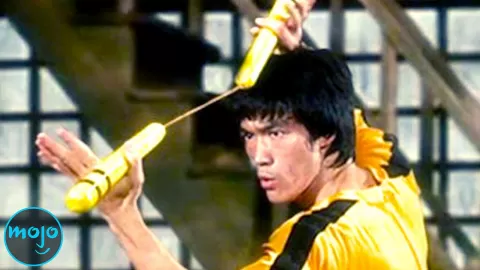The 10 Most Difficult Weapons to Master

#10: Nunchaku
Let’s start with a weapon made famous in popular culture. The nunchaku, with its dual swinging sticks connected by a chain or cord, demands an extraordinary level of coordination and skill. Mastery involves cultivating dexterity and timing to wield them effectively without injuring oneself. The dynamic and unpredictable nature of the nunchaku requires practitioners to develop lightning-fast reflexes and a thorough understanding of its physics, allowing for fluid transitions between strikes and defensive maneuvers. Training extensively with the nunchaku involves a repertoire of spins, strikes, and blocks. The nunchaku’s unconventional design and the emphasis on fluidity make it a formidable challenge.
#9: Whip
Whip it! Whip it good! The whip is deceptively simple yet highly versatile. Using one involves understanding the intricacies of the whip's flexibility, allowing for both precision strikes and defensive maneuvers. Whip-wielders require a keen sense of spatial awareness to avoid self-injury, as the whip's quick movements leave little room for error. Practitioners must develop a unique feel for its momentum, perfecting various cracking techniques and targeting strategies. The whip's adaptability, both long-range and close-quarters, makes it deadly. Dedication and precision are paramount.
#8: Boomerang
Let’s bring this list back around to the boomerang. This traditional weapon , with its returning flight pattern, is a challenging tool that demands a deep understanding of aerodynamics and control. Using a boomerang effectively involves precise throwing techniques, accounting for its unique shape and the environmental factors affecting its flight. Boomerangs demand the artistry of wrist flicks, angles, and spins to ensure the boomerang returns accurately. Practitioners must adapt to different boomerang shapes and sizes, each requiring a nuanced throwing approach. The boomerang’s dual functionality, as both a ranged attack and a returning projectile, adds an extra layer of sophistication.
#7: War Hammer
Stop - hammer time! The war hammer, an imposing threat, demands exceptional strength, precision, and strategic acumen. Achieving proficiency involves mastering the art of delivering devastating blows while maintaining control over its weight and momentum. The hammer requires practitioners to adapt to different striking surfaces, whether blunt force for armor penetration or precise blows to vulnerable areas. The balance between offense and defense, coupled with the war hammer’s sheer power, makes the war hammer a formidable challenge. Physical prowess is paramount for those seeking true control of its power.
#6: Throwing Knives
Throwing knives require precise skill involving a deep understanding of aerodynamics and muscle control. Most important is the art of rotation and distance, ensuring the blade hits its mark with accuracy. The balance between finesse and force is crucial, as too much or too little power can lead to inconsistent results. Practitioners must develop muscle memory for various throwing techniques, adapting to different knife shapes and weights. The margin for error is minimal, and consistent practice is necessary to achieve the necessary level of precision.
#5: Flail
All hail the flail. The flail is unique and unpredictable, and is a lethal threat that demands an extraordinary level of coordination and timing. Becoming an expert involves controlling the chain and weighted heads to deliver powerful and unpredictable strikes. The flail's chaotic attack adds an element of surprise, making it challenging for opponents to predict the trajectory of attacks. Practitioners must develop a keen sense of spatial awareness to avoid self-injury, as the flail's movements can be as hazardous to the wielder as to the opponent. The ability to seamlessly transition between offensive and defensive maneuvers is key.
#4: Katana
The katana, a revered Japanese sword, demands a profound commitment to the art of Kenjutsu. Proficiency involves rigorous training in proper grip, stance, and precise cutting techniques. The katana's razor-sharp blade requires practitioners to develop acute spatial awareness to avoid self-injury. Mastery extends beyond physical prowess, requiring an understanding of the katana's cultural and historical significance. Practitioners must embody the principles of Bushido, emphasizing discipline, honor, and mental focus. The katana's unique design and the philosophy surrounding its use demand a lifetime of dedicated practice.
#3: Halberd
Talk about menacing.The halberd, a versatile polearm combining an axe, spear, and hook, demands a unique blend of strength, agility, and tactical finesse. This potentiates a diverse range of attacks, from sweeping strikes to thrusts and grappling maneuvers. The halberd's multi-functional nature requires practitioners to adapt to various combat scenarios, making it effective against both armored and unarmored opponents. The combination of reach, cutting power, and the ability to dismount opponents from horseback adds serious complexity to using the halberd. Strategic thinking is extremely important for any halberd-wielder.
#2: Sniper Rifle
Sniper rifles demand an intricate blend of patience, precision, and a deep understanding of ballistics. The slightest miscalculation in wind speed, distance, or bullet drop can lead to missed shots. Becoming a sniper involves honing marksmanship skills, meticulously calculating trajectories, and adapting swiftly to changing environmental factors. The emphasis on stealth and maintaining situational awareness elevates the learning curve. Expertise is earned through rigorous training, where shooters learn to control breathing, manage heartbeat fluctuations, and make split-second decisions.
#1: Longbow
Longbows, with their historical significance and reliance on raw power, present a formidable challenge. Archers must cultivate strength, endurance, and an innate feel for the bow's unique draw characteristics. Achieving accuracy requires consistent form, emphasizing a fluid and controlled release. Longbows lack the mechanical advantages of modern bows, demanding archers to develop a deep understanding of arrow flight and the effects of weather on trajectory. Mastery involves honing instinctive shooting, relying on muscle memory for consistent results. The commitment required to harness the longbow's potential places it among the most challenging traditional ranged weapons to wield well.
Are there any other weapons that you think are particularly tricky to master? Let us know in the comments.


 0
0
 0
0
 report
report

 0
0
 0
0
 report
report

 0
0
 0
0
 report
report